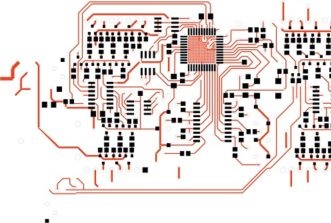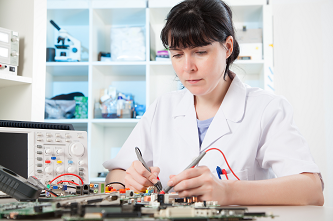Hottest Electronic Trends for 2022
17/01/2022, hardwarebee
Last year was not a conventional year for society, which of course includes the global industry. The COVID-19 pandemics showed the world how fragile the fabric of economics can be, and the US-China trade war added more gasoline to the fire. In the electronics world, the chip shortage was the most remarkable 2021 event, disrupting entire supply chains and causing huge economic impact. Furthermore, our relationship with the work environment changed abruptly, with most of the world working from home for several months. Now, society is finally recovering, and although the post-pandemic world is uncertain, it brings the hope of better times. In this article, we discuss the main electronic trends for 2022, including the future of chip shortage, the impact of home-office in the market, 5G, IoT, the automotive industry, biomedical devices, the metaverse and sustainability.
The Hardware of the Metaverse Kicks Off
The metaverse is a concept that recently reached mainstream media, and is already causing confusion and speculation among people. The term itself refers to a virtual world where human-machine interface is as natural as possible, and the system is capable of enhancing reality experience. However, it does not specify any particular technology or method. Therefore, no one really knows what the metaverse is (or will be), but the giants of the digital world, such as Facebook and Nvidia, are already building it. To become a reality, the metaverse needs a solid hardware infrastructure. Although the metaverse is not expected to happen anytime soon, this new market can be a great opportunity for consumer electronics developers.
The electronics necessary are less oriented on task efficiency and completely optimized for user immersion. Virtual-reality headsets and augmented-reality glasses are the primary windows to the metaverse, as they can provide full visualization of the virtual world, with hands-free operation. Although the technology behind VR headsets and AR glasses improved significantly over the last few years, the pixelation, limited range of vision and limited frames per second are problems that must be overcome before reaching an experience close to the real life. The resolution problem can be fixed by using eye-tracking technology, focusing the high-resolution part only at the center of vision.
Wearable controllers, such as smart-watches and haptic gloves, are the foundations of the metaverse human-machine interaction, but as the immersion grows gloves may not be enough, so more developments in haptic clothing are welcome. Their implementation combined with sensory feedback systems provide a deeper immersion into the virtual reality by reproducing the sense of touch. The metaverse also intends to replicate, or at least get inspired by, real places to build the virtual world, which full real-time tracking capabilities require cutting-edge laser scanners and cameras.
Working from (a Smarter) Home
The COVID-19 pandemics completely changed our relationship with work, and home office became the norm for many months. Suddenly, the industry realized that it needed large numbers of reliable and quality equipment to perform virtual calls, meetings, and remote work. Because the virtualization of the workplace is expected to stay, the consumer electronics industry will grow in this segment, due to the increase in demand. Moreover, the need for more user-friendly, ergonomic, and efficient experiences for the worker will spark innovation. However, this can only happen if the chip crunch eases in 2022, as they are fundamental for mass production.
As users spend more time at home, the interest in home automation and smart gadgets gained a new momentum. The recent developments in Internet of Things (IoT) and 5G also brought new heat to the segment. The smart home operational system Matter will be launched in 2022, bringing the beginning of system standardization for devices connected to domestic networks. A stable standard protocol will provide easier ways to develop, integrate and apply different products in home automation. Moreover, it is expected that more than 53.9% of US homes will implement smart devices by 2023, and the global smart home market should reach US$53.5 billion by 2022. Smart security devices are also of great interest for home applications, with market spending reaching US$53.5 billion by 2024.
5G and Internet of Things Ramp Up
The 5G technology has finally arrived, and with it a new generation of IoT and network technology. Currently, 5G is predominantly applied in consumer use cases, but custom private 5G networks powered by mmWave devices promise to connect industry equipment with high-speed, high-capacity, and low-latency communication, making it some of the most hyped technologies. Companies expect to obtain time-sensitive networking with millisecond latencies and reliable determinism to protect the system from invasion or interference. However, enterprise 5G networks may not gain the market yet, as devices compatible with the 3GPP Release 16 are still out of the market.
IoT healthcare is also growing strong, which was expected after the pandemics. The current trend in healthcare is to design wearable medical devices, which are connected to the body via clothing, although the category also includes wheelchair, defibrillators, and ventilators. The connectivity between health monitoring and treatment devices, such as heart rate monitors, insulin pumps, glucose monitors and oxygen pumps, is desirable to facilitate real-time tracking, remote medical assistance, and automatic actuation. IoT devices can also be used for disease transmission control, by identifying and preventing possible infected people from agglomerating at a certain point, or using cameras to monitor social distancing.
The connection of medical equipment to the internet imputes the possibility of malicious invasions, so security is a major concern. Security in the IoT area is not easy: according to Kaspersky, more than 1.5 billion hacker attacks to IoT devices were registered in 2021, and the number is expected to increase this year. Therefore, security focused IoT design is definitely coming soon, as the pressure from both customers and governments is reaching a critical point. Beyond 5G, the interested towards 6G, which can be 100 times faster, technology will increase in 2022. Geopolitical giants, such as China and the US, started researching the 6G in 2018, and it is likely that we will hear new launches and announcements concerning the technology in this year.
More Chips into Cars
The segment that suffered the most from the chip shortage issue, losing more than 210 billion dollars in 2021. Unfortunately, the shortage will continue in 2022, so one should expect the prices of automotive components to rise significantly until 2023. However, the popularization of electrical vehicles continues, and the EV leader Tesla managed to survive the chip scarcity with considerable profits, showing that the segment can prosper in the adversity.
In terms of innovation, it is not really new that the automotive industry is running towards autonomous vehicles. Self-driving EV are the current holy grail of mobility engineering, with promises of reducing the chance of accidents, the environmental footprint, and time and cost of transportation. Mercedes Benz obtained the first Level-3 autonomous vehicle approval last year, and is seeking to launch the model in 2022. The level-3 autonomy allows the drive to take the eyes of the road and the hand off the wheels while driving, but the driver is still needed. True autonomy is only obtained at Level-4 vehicles, and Tesla, Google, Ford, and Mercedes are some of the companies seeking this level. This means that the demand for automotive sensors (LiDAR, ultrasonic sensors, cameras), artificial intelligence ASICs and advanced communication modules (for in-car and car-to-car transmission) will increase in the next years.
Chip Shortage Continues Beyond 2022
In the year of 2020 the demand for chip production increased significantly due to the COVID-19 pandemics and the economic instability caused by the US-China trade-war. The sudden spike in demand made chip fabs operate at full capacity, with no space for delays. The situation was aggravated by weather issues, such as the Taiwan drought that jeopardized the production of the giant TSMC and fire incidents in fabrication plants in Japan (AKM and Renesas) and in lithography equipment providers in Germany (ASML). The chip shortage affected more than 169 industries, especially automotive and consumer electronics companies. Unfortunately, the chip crunch will likely stay at least until the end of 2022, so high-end electronics developers must find alternatives to escape recession.
Although problematic, the shortage can bring opportunities to several technology segments. Chip manufacturing behemoths, such as TSMC, Intel and Samsung, are planning to build new fabrication plants in the US, to decentralize chip manufacturing and, hence, increase the level of immunity of the IC production to external affairs, preventing future shortages. This opens an opportunity for the chip manufacturing equipment sector, including wafer processing, fabrication facilities and mask/reticle equipment. The market value reached the mark of US$ 100 billion in 2021, a 44.7% growth when compared to 2020, and it is expected to increase to US$ 114 billion this year.













